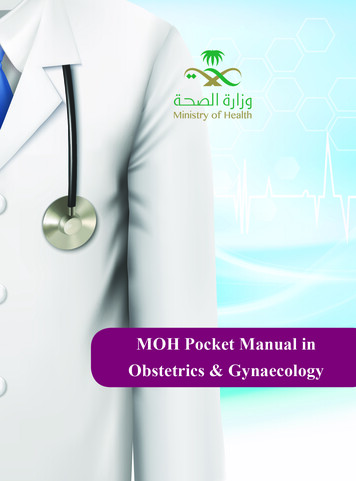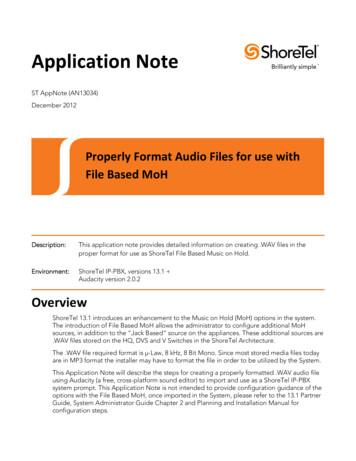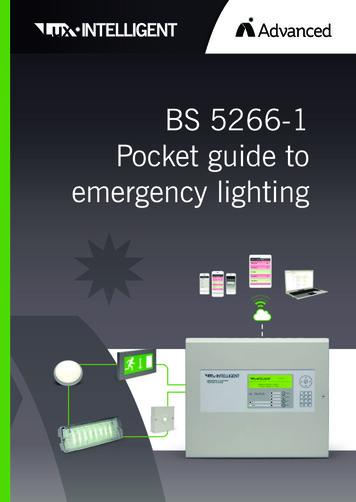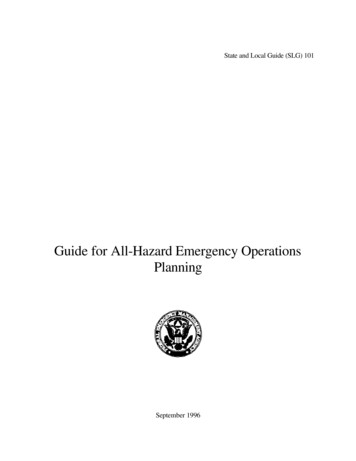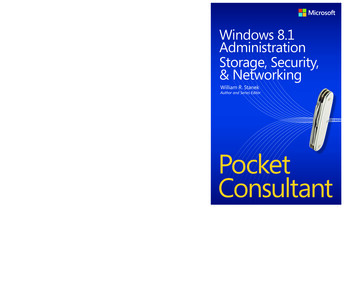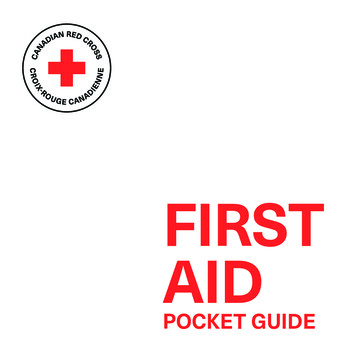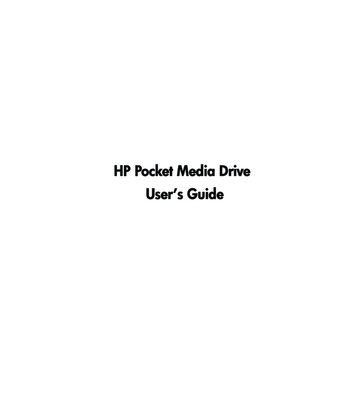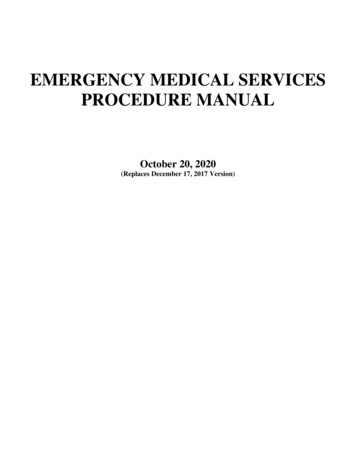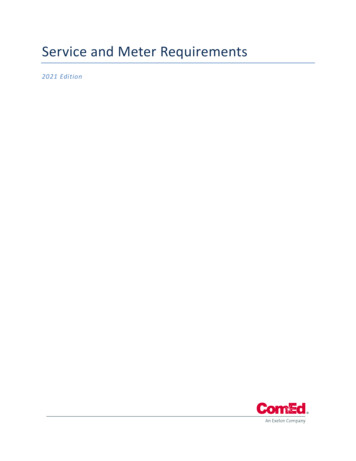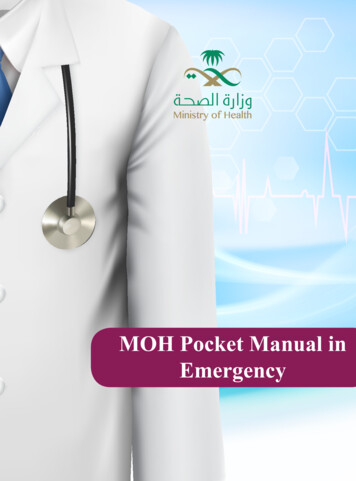
Transcription
MOH Pocket Manual inEmergency
MOH Pocket Manual in EmergencyCOntentscardiac emergency3
MOH Pocket Manual in EmergencyContentsChapter 1: Cardiac emergency: Acute ST Elevation Myocardial Infarction1 . Non ST Elevation Myocardial Infarction.Atrial fibrillation. Bradydysrhythmias. Hypertension. Acute Aortic Syndromes. Deep Venous Thrombosis.Chapter 2: Pulmonary emergency: Acute bronchial Asthma.Chapter 3 : Neurological emergency: Headache. Adult Acute Bacterial Meningitis.Chapter 4 :Toxicology: Acetaminophen (Paracetamol, APAP) Overdose. Carbon Monoxide Poisoning.Chapter 5 : Hematological emergency: Sickle cell disease in emergency department. Anticoagulation Emergencies.Chapter 6 : Endocrinology and electrolyte emergency: Hypokalemic and Hyperkalemia Emergencies. Diabetic emergency.4conten t
MOH Pocket Manual in Emergency Thyroid Storm and Myxedema ComaChapter 7 : Urological emergency: Rhabdomyolysis. Acute Urinary Retention.Chapter 8 : Trauma and environmental: Severe Traumatic Brain Injury. Electrical Injuries. Heat injury.Chapter 9 : Medications Listcon t en t5
MOH Pocket Manual in Emergency6cardiac emergency
MOH Pocket Manual in EmergencyChapter1CRADIACEMERGENCYcardiac emergency7
MOH Pocket Manual in EmergencyAcute ST Elevation and NonST Elevation Myocardial InfarctionOverviewAcute coronary syndrome involves:1.ST elevation acute myocardial infarction2.Non–ST-segment elevation acute myocardial infarction3.Unstable angina (UA).Acute ST elevation myocardial infarction typically occurs whena clot leads to complete occlusion of a coronary artery with transmural , or full thickness myocardial infarction .The ECG will show ST segment elevation in the involved areaof the heart.Non–ST-segment elevation acute coronary syndromes (NSTEACS) refers to a disease process characterized by reducedcoronary blood flow resulting in coronary ischemia without STsegment elevations on an electrocardiogram (ECG).NSTE-ACS include both non–ST-segment elevation acute myocardial infarction (MI), as defined by positive biomarkers for MI,and unstable angina (UA), as defined by negative biomarkers.8cardiac emergency
MOH Pocket Manual in EmergencyClinical Presentationo History Chest pain, when it started, what it feels like(stabbing, crushing, pressure, aching), and ifit radiates to other parts of the body. Jaw/shoulder/ neck/arm pain. Dizziness, nausea. Shortness of breath.o Physical Examination Hemodynamic stability, signs of heart failure/left ventricular dysfunction. Exclusion of noncardiac and nonischemic cardiaccauses requires a thorough examination of the patient’s chest wall―including inspection and palpation―as well as careful examination of cardiacand pulmonary functions.cardiac emergency9
MOH Pocket Manual in EmergencyDifferential diagnosiso HeartAcute coronary r diseaseo LungsPulmonary embolusPneumothoraxPneumoniaEmpyemaHemothoraxCOPDo EsophagusEsophagitisGERDSpasmForeign bodyRupture (Boerhaave’s)Esophegeal Tearo Work up CBC. Electrolytes. Coagulation studies. Cardiac enzymes. ECG. Cardiac biomarkers.10cardiac emergency
MOH Pocket Manual in EmergencyManagemento Prehospital Care: Three goals:(1) Delivering patients to an appropriate health care facility asquickly as possible.(2) Preventing sudden death and controlling arrhythmias by usingacute cardiac life support (ACLS) protocol when necessary.(3) Initiating or continuing management of patients during interfacility transport. Checklist to get from the EMS team includes the following information:1. The person who initiated EMS involvement (patient, family,bystander, transferring hospital) and why.2. Complaints at the scene.3. Initial vital signs and physical examination results, as well asnotable changes.4. Therapies given prior to arrival and the patient’s response.5. ECGs done at an outside hospital or en route, noting the contextin which notable ECGs were printed.cardiac emergency11
MOH Pocket Manual in Emergency6. The patient’s code status (if known).7. Family contacts for supplemental information and family members who may be on their way to the ED, as they may be helpful in completing or verifying the history.In hospital care for STEMI:12 Assess and stabilize airway, breathing, and circulation. Do ECG. Provide oxygen; attach cardiac and oxygen saturationmonitors; establish IV access. Treat arrhythmia rapidly according to ACLS protocols. Give aspirin 162 to 325 mg (non-enteric coated), to bechewed and swallowed (allergy to aspirin is an absolute contraindication) . Give three sublingual nitroglycerin tablets (0.4 mg) oneat a time, spaced five minutes apart if patient has persistent chest discomfort, hypertension, or signs of heartfailure and there is no sign of hemodynamic compromise and no use of phosphodiesterase inhibitors, inferior MI with right ventricular extension. Give morphine sulfate (2 to 4 mg slow IV push every 5to 15 minutes) for persistent discomfort or anxiety.cardiac emergency
MOH Pocket Manual in EmergencySelect reperfusion strategy: Primary percutaneous coronary intervention (PCI)strongly preferred, especially for patients with cardiogenic shock, heart failure, late presentation, or contraindications to fibrinolysis. Treat with fibrinolysis if PCI unavailable within 90-120minutes, symptoms 12 hours, and no contraindications Give antiplatelet therapy (in addition to aspirin) to allpatients: Patients treated with fibrinolytic therapy:Give clopidogrel loading dose 300 mg if ageless than 75 years; if age 75 years or older,give loading dose of 75 mg. Give anticoagulant therapy to all patients: Unfractionated heparin:-For patients undergoing primary PCI, we suggest an initial intravenous (IV) bolus of 50 to 70 units/kg up to a maximum of5000 units.-For patients treated with fibrinolysis, we suggest an IV bolus of60 to 100 units/kg up to a maximum of 4000 units and for patients treated with medical therapy (no reperfusion) an IV boluscardiac emergency13
MOH Pocket Manual in Emergencyof 50 to 70 units/kg up to a maximum of 5000 units.-Both should be followed by an IV drip of 12 units/kg per hour(goal aPTT time of 1.5 to 2 times control or approximately 50to 75 seconds).Disposition Admit to ICUIn hospital care for NSTEMI:o Management High-risk patient::”Early “invasive1. Discuss with cardiology.2. Clopidogrel 300 mg or GPIIb/IIIa inhibitor.3. Prompt PCI. Not high-risk patient:-Early “conservative”:Clopidogrel 300 mg.14cardiac emergency
MOH Pocket Manual in EmergencyDisposition Admit to ICU.o Alert Sudden onset of severe pain. Occurring during exercise. Lasting longer than 15 minutes. Associated with shortness of breath. Nausea/vomiting and sweating. Radiation to left arm or jaw. In case of inferior myocardial infarction , you must doRight side and Posterior ECGs to rule out Right ventricular or Posterior MI .cardiac emergency15
MOH Pocket Manual in EmergencyAtrial Fibrillation: Management StrategiesOverviewo Cardiac causes: Mitral valve disease. Myocardial disease. Conduction system disorders. Wolff-Parkinson-White syndrome. Pericardial disease.Conditions associated with AF include:16 Thyrotoxicosis. Hypothermia. Alcohol use. Severe infection. Hypoxia. Pulmonary emboli. Pneumonia. Kidney disease. Obesity. Diabetes mellitus. Digoxin toxicity. Electrolyte abnormalities. Intrathoracic surgery, such as cardiac or pulmonarysurgery, or invasive cardiac studies.cardiac emergency
MOH Pocket Manual in EmergencyAtrial Fibrillation is categorized as follows: First detected episode. Recurrent (after two or more episodes). Paroxysmal (if recurrent AF terminates spontaneously). Persistent (if sustained beyond 7 days).Clinical Presentationo History Anxiety, palpitations, shortness of breath,dizziness, chest pain, or generalized fatigue. Medications and alcohol and drug use.Physical Examination Vital signs. Oxygen saturation. Evidence of thyroid disease (eg, exophthalmos and enlarged thyroid). Evidence of deep vein thrombosis/pulmonary embolus(e.g., unilateral lower extremity swelling or tenderness). The cardiac evaluation: rate, rhythm, and the presenceof heart murmurs.cardiac emergency17
MOH Pocket Manual in EmergencyDifferential 00-180Precedes everyQRS complexAtrialfibrillation400-600irregu ,60-1900larly irregularAbsentAtrialflutter250-350regu ,75-1500lar, odalreentranttachycardia180-250180-250In QRS complex)(R75-250Precedes QRS;P-wave differsfrom sinus Pwave100 or more dif 3ferent P-wavemorphologies atdifferent ratesAtrialtachycardiaMultifocal atrialtachycardia18120-250100 cardiac emergency
MOH Pocket Manual in EmergencyAtrialfibrillation withWolffParkinsonWhitesyndrome400-600with ,180-300wide, bizarreQRS complexesAbsentWork up Electrocardiogram. Complete blood cell count. Metabolic panel. Hepatic function panel. Coagulation studies. A thyroid panel. Chest radiography.cardiac emergency19
MOH Pocket Manual in EmergencyManagemento Prehospital Care: Cardioversion considered if the patient exhibits signsof hemodynamic compromise or poor coronary arteryperfusion.o In hospital care: Unstable Patients: as :-Altered mental status.-Ischemic chest discomfort.-Acute heart failure.-Hypotension.-Signs of shock or hemodynamic compromise.o Immediate direct current cardioversion: 200 J biphasic. 200-360 J monophasic. Can consider lower energy for atrial flutter. Anticipate failure.20cardiac emergency
MOH Pocket Manual in Emergencyo If no success repeats direct current cardioversion: Increase energy level. Consider anterior-posterior pad placement for biphasicdefibrillators. Time with patient’s respiratory cycle, shock during fullexpiration. Stable Patients:If Suspicion for accessory pathway? Wide, bizarre QRS complexes. Ventricular rate 250 bpm. History of Wolff-Parkinson-White syndrome. Prior ECG with delta wave.o Give: Amiodarone.If No suspicious of accessory pathway: Diltiazem 0.2 mg/kg slow IV bolus or 2.5 mg/mindrip up to 50 mg total. Amiodarone: 150 mg over the FIRST 10 minutes (15Orcardiac emergency21
MOH Pocket Manual in Emergencymg/min) followed by 360 mg over the NEXT 6 hours(1 mg/min) then 540 mg over the REMAINING 18hours (0.5 mg/min). Beta blockers as :Esmolol 0.5 mg/kg over one min loading dose then 0.06-0.2 mg/ kg/ minMetoprolol 2.5 -5 mg bolus over 2 min , up to 3 doses.o Disposition22 Admission of new-onset AF only for patients with decompensated heart failure or myocardial ischemia orfor patients who are highly symptomatic and in whomadequate rate control cannot be achieved. Follow your hospital policy of admission .cardiac emergency
MOH Pocket Manual in Emergencyo Alert Palpitations during exertion or palpitations withassociated syncope or pre-syncope. ECG abnormalities. Family history of sudden cardiac death or witha first-degree relative affected by an inheritableheart condition. Cardioversion needs procedural sedation and analgesia.cardiac emergency23
MOH Pocket Manual in EmergencyBradydysrhythmiasOverviewCategories of hythmia TypeSinus node dysfunc- tion AV blocks24cardiac emergencySinus bradycardiaSinus arrest Tachy-brady syndrome Chronotropic incompetence First-degree AV block Second-degree AV block (Mobitz type I orWenckebach) Second-degree AV block (Mobitz type II) Third-degree AV block (complete heart block)
MOH Pocket Manual in EmergencyClinical PresentationHistoryAssessing the History of the Patient with BradydysrhythmiaHistoryPossible Underlying PathologyPreceding angina symptomsMyocardial ischemia/infarctionFevers, travel to endemic areas, tick biteInfectious agentCold intolerance, weightgain, increased fatigueHypothyroidismHeadache, mental statuschange, recent headtrauma, fallsIntracranial causes, including intracranial hemorrhageAbdominal pain ordistentionIntra-abdominal hemorrhageRecent additions orchanges to medicationsDrug toxicityHistory of end-stagerenal disease, receivingdialysisHyperkalemiacardiac emergency25
MOH Pocket Manual in EmergencyCancer history, receivingtreatmentAcute or long-term toxicity fromchemotherapeutic agentsSevere pain, anxiety,strong emotion preceding the eventVasovagal reflex, neurocardiogenicPhysical Examination Perfusion can be confirmed with the identification ofstrong peripheral pulses, brisk capillary refill, and warmextremities.Evidence of heart failure may be suggested by lowerextremity edema, elevated jugular venous distention, orrales in the lower lung fields.o Differential diagnosis26cardiac emergency
MOH Pocket Manual in EmergencyCategoryDisease ProcessIschemia andinfarctionInferior myocardial infarction, especially involving the right coronaryarteryNeurocardiogen ic or reflex-mediatedVasovagal reflexHypersensitive carotid sinus syndromeIntra-abdominal hemorrhageIncreased intracranial pressureMetabolic, en docrine, and environmentalHypothyroidismInfectious andpostinfectiousChagas disease (Trypanosoma cruzi)HyperkalemiaHypothermiaLyme disease (Borrelia species)Viral agents (parvovirus B19, coxsackievirus B, etc)Syphilis (Treponema pallidum)ToxicologicTherapeutic doses of prescribeddrugs, overdoses of drugs, orpoisoningcardiac emergency27
MOH Pocket Manual in EmergencyWork up Electrolyte levels, especially potassium. A drug level should be obtained on all patients who are currently taking digoxin. Thyroid function testing. Cardiac biomarkers. CT of the head. Chest x-ray.Managemento Prehospital Care:28 Maintain patent airway; assist breathing as necessary. Oxygen (if hypoxemic). Cardiac monitor to identify rhythm. Monitor blood pressure and oximetry. IV access. 12-lead ECG, if available.cardiac emergency
MOH Pocket Manual in Emergency Looking for evidence of hemodynamic instability,including hypotension and altered mentation. Treated in the field and en route to the ED by protocolsand procedures based on the Advanced Cardiac LifeSupport (ACLS) algorithm.In hospital:o The Unstable Patient: Airway control, oxygen administration, and ventilatoryassistance. Atropine administration remains the first-line medication for unstable and symptomatic patients withbradydysrhythmias:-The recommended dose is 0.5 mg intravenously every 3 to 5 minutes, with a maximum dose of 3 mg. If atropine administration has been ineffective, a betaadrenergic agent (such as dopamine, epinephrine, orisoproterenol) should be considered.- Dopamine infusion should be initiated at 2 to 10 mcg/kg/min inpatients who have failed to improve with atropine.Or- Epinephrine I V infusion 2 to 10 mcg/min .cardiac emergency29
MOH Pocket Manual in Emergency Pacing should be initiated in unstable patients who havenot responded to atropine or beta-adrenergic agents.The Stable Patient: Identify the underlying etiology of the bradydysrhythmia.Drug or ToxinBeta blockersSpecific Antidotes and Therapies for Toxicological Causes of BradydysrhythmiasAntidote or TherapyGlucagon: 5 mg IV; can be repeated every 10min, up to 3 dosesCalcium gluconate 10%, 30 to 60 cc IV -Calcium channel blockersInsulin (regular): 1 unit/kg bolusunits/kg/h infusion; supplementas needed 0.5 glucoseDigitalis (di)goxinDigoxin immune Fab (Digibind or DigiFab ): empirically, 10-20 vials (if serum digoxin level is available, product insert can be)used for more exact dosing guideOpioidsNaloxone: 0.4 mg IV, then 2 mg IV if no responseOrganophosphates30Atropine: 2 mg IV; double every 3-5 min untilpulmonary secretions are manageablePralidoxime (2-PAM): 2 g IV over 10-15 min,repeated every 6 hcardiac emergency
MOH Pocket Manual in EmergencyDisposition Symptomatic bradydysrhythmias are admitted. Unstable patient admitted to ICU.HypertensionOverviewDefinitions of HypertensionHypertensive emergencyBlood pressure 140/90 mm Hg with impending or progressiveTarget organ dysfunctionHypertensive urgencyBlood pressure 180/120 mm Hg without impending or progressiveTarget organ dysfunctionHypertensive crisisA hypertensive emergency or urgencyMean arterial pressureAverage blood pressure reading over 1 cardiac cycle; can becardiac emergency31
MOH Pocket Manual in EmergencycalculatedAs [systolic blood pressure (2 x diastolic blood pressure)] 3Essential hypertensionHypertension without a specific secondary causeSecondary hypertensionHypertension related to an underlying pathologic process, e.g.,adrenal disease; renal disease; or drug effects, interactions, orwithdrawal.Clinical PresentationHistoryKey Questions Regarding History of the Present IllnessQuestion Comments/Concerns- Have you ever been told you have high blood pressure?Open-ended, inclusive question; many people do not think theyhave high blood pressure if they are taking—or have in the pasttaken—medication for it.- Do you have any chest pain?Myocardial infarction, aortic dissection32cardiac emergency
MOH Pocket Manual in Emergency- Do you have any shortness of breath?Myocardial infarction, aortic dissection, pulmonary edema, heartfailure- Are you on any medications, or are you using any recreationaldrugs or herbal medicines? Neuroleptic malignant syndrome;serotonin syndrome; cocaine, phencyclidine, or other sympathomimetic.- Have you recently stopped taking any medications or recreational drugs or herbal medicines?Delirium tremens, clonidine and other drug withdrawal- Have you had any focal weakness, slurring of speech, numbness,or clumsiness?Stroke, transient ischemic attack, intracranial hemorrhage- Do you snore or wake up during sleep? Do you feel tiredthroughout the day? Obstructive sleep apnea- Have you had high blood pressure in the past that has not responded to multiple medications?cardiac emergency33
MOH Pocket Manual in EmergencyPhysical Examination Vital signs should be checked and rechecked,including pulses and BPs in all extremities. A funduscopic examination. Checking the thyroid and reflexes. A complete cardiopulmonary examination iscritical for establishing the patient’s baseline,and an abdominal examination should assessfor evidence of an aortic aneurysm. The neurologic examination.Differential Diagnosis34 Stroke. Aortic dissection. Drug intoxication: cocaine, amphetamine,monoamine oxidase inhibitor. Drug withdrawal: antihypertensive, alcohol,sedative hypnotics. Renal failure. Pheochromocytoma or other.cardiac emergency
MOH Pocket Manual in Emergency Tumor. Thyroid storm.Work up Complete blood cell count. Serum chemistry. Electrocardiogram. Chest radiograph. Urine drug screen. Urinalysis. Pregnancy test.o Managemento Prehospital Care Evaluated for signs or symptoms of endorgan damage. History, including the medications.cardiac emergency35
MOH Pocket Manual in EmergencyIn hospital care:Asymptomatic Patients with BP Less Than 180/110 mm Hg:-Patients with BP measurements less than 180/110 mm Hg withno signs of End organ damage ,do not need to be treated in theED-Instead, these patients should follow up with a primary careprovider within 1 week.Patients with BP Over 180/110 mm Hg and a History OfHypertension on Antihypertensive Medications:-If these patients have missed their medications, they may berestarted on the drugs.-Efforts should be made to ensure that the barriers that preventedthe patient from taking the medications are addressed.-For those patients who are compliant with their medications butstill have an elevated BP, adjustments must be made.Asymptomatic Patients with BP Over 180/110 mm Hg and NoHistory of Hypertension:-In this scenario, patients should be started on antihypertensivemedication ( no need to aggressive lowering of BP ) , and regular follow-up in OPD clinic .36cardiac emergency
MOH Pocket Manual in EmergencyParenteral Drugs for Treatment of HypertensiveEmergencies:DrugDoseOnset ofActionDuration eemergencies;andcyanideintoxication. Maycautionwithhighincreaseintracranial dium 0.25-10nitroμg/kg/prusside min asIV infusionImmediate1-2 minazotemiacardiac emergency37
MOH Pocket Manual in EmergencyNicardipinehydrochloride5-15mg/hIV5-10 min( notin theMOHformulary ertensiveemerexceed 4hrslocal phle- onaryischemia0.1-0.3μg/kg/min IV 5 mininfusion30 nsiveemergencies;cautionwithglaucoma38cardiac emergency
MOH Pocket Manual in EmergencyNitroglycerin5-100μg/minas IV2-5 prilat( notin theMOHformulary )1.25–5mgevery 6hrs IV15-30min6-12 hrsPrecipitous fall inpressure ac emergency39
MOH Pocket Manual in EmergencyHydralazinehydrochloride10-20mg IV10-20min IV1-4 hrsIV10-40mg IM20–30min IM4-6 ng,aggravation ofanginaAdrenergic InhibitorsLabetalolhydrochloride20-80mg IVbolus5-10 minevery10 min0.5-2.0mg/minIVinfusion3-6 hrsVomiting, ,heartblock, orthostatichypotension40cardiac rtfailure
MOH Pocket Manual in EmergencyEsmololhydrochloride250–500 μg/kg/1-2 min10-30minmin IVbolus,thenHypotension,nausea,asthma,first-degree heartblock,heart50–100μg/kg/min yrepeatbolusafter 5min orincreaseinfusion to300 μg/minPhentolamine5–15mg IVbolus1-2 min10-30minTachycardia,flushing,headachecardiac emergencyCatecholamineexcess41
MOH Pocket Manual in EmergencyOutpatient Oral Medications for Hypertension Management:AgentStartingDoseMaximumUseful DosageIndicationContraindicationThiazide12.5 mgdaily25 mg dailyDrug ofchoice forGout, , iadiuretics(eg,hydrochlorothiazide)works wellwith otheragentsACEinhibitor5-10 mgdaily(eg, fosinopril,lisinopril)40 mg dailyPatientswith CHF,diabetes,previousMI withlow ejectionfraction42cardiac emergencyBilateralrenal arterystenosis; hypovolemia
MOH Pocket Manual in 5-50 mgdaily100mg dailySimilarefficacy toACEinhibitors;used forBilateralrenal arterystenosis; hypovolemiapatientswho cannottolerate theseinhibitorsor in addition tothemcardiac emergency43
MOH Pocket Manual in Emergencyβ-Blockers(eg,25-50 mgbidmetoprolol)200 mg bidPatientswith coronaryarterydisease;longtermmanagementof CHF;rate control;hyperthyroidismNot a goodmonotherapyfor lonehypertension;heart block;bradycardia;sick sinussyndrome;bronchospasm;acute decompensatedCHF exacerbation44cardiac emergency
MOH Pocket Manual in EmergencyCalciumchannel180-240mg360-540 mgdailyblockersDaily(formulationdependent)(eg, diltiazem)Ratecontrol orcoronaryarterydisease inpatientswho cannottakeβ-blockersNot a goodmonotherapyfor lonehypertension;long-actingagents aresafer thanshort-actingagents; heartblock;bradycardia;acutedecompensated CHFexacerbation;sick sinussyndromea-2 Agonist (eg,clonidine)0.1 mgbid0.3 mg tidHypertensionresistantPoor adherence to medicalto othermodalitiesregimencardiac emergency45
MOH Pocket Manual in EmergencyHydralazine10 mg 4qid(unknownmechanism ofvasodilation)100 mg tidHypertension associatedwith pregnancy;hypertension associatedwith CHFin AfricanAmericansresistant toothermodalities46cardiac emergencyCoronary artery disease
MOH Pocket Manual in EmergencyDisposition If the BP is greater than 200/120 mm Hg ,oral antihypertensive therapy should be started. For BPgreater than 180/110, follow-up should occur within 1 week. If prompt follow-up cannot be ensured,then further consideration for BP treatment or titration of existing BP medications should be given. For BP greater than 140/90 mm Hg, follow-up withinone week is recommended. Patients with hypertensive emergencies admitted to theintensive care unit after receiving titratable IV antihypertensive agents.cardiac emergency47
MOH Pocket Manual in EmergencyAcute aortic emergencyOverviewAcute aortic syndrome is defined as three related conditions:(1) Aortic dissection.(2) Intramural hematoma.(3) Penetrating atherosclerotic ulcer.Aortic dissection is defined as: Acute if it occurs within 2 weeks of the onset ofsymptoms. Subacute if it occurs between 2 and 6 weeks. Chronic if it occurs more than 6 weeks from theonset of pain. (Some authors describe aortic dissections 2 weeks as chronic).Two main anatomic classification systems for aortic dissections:that are defined based on the involvement of the proximal aorta(1) The DeBakey classification.(2) The Stanford classification.48cardiac emergency
MOH Pocket Manual in EmergencyIn the DeBakey classification, there are 3 types. Type I originates in the ascending aorta and extendsinto the aortic arch and descending aorta. Type II is confined only to the ascending aorta. Type III originates in the descending thoracic aorta andis further subdivided into type IIIa, which is limited to the descending thoracicaorta. type IIIb, which extends below the diaphragm.The proximal aorta is defined as the aorta proximal to the brachiocephalic artery; the descending aorta is defined as the aorta distalto the left subclavian artery.In the Stanford classification system, aortic dissection is defined.according to whether the ascending aorta is involved or not Stanford type A dissections involve the ascendingaorta (similar to DeBakey type I and II). Stanford type B dissections involve the descendingaorta (similar to DeBakey type III).cardiac emergency49
MOH Pocket Manual in EmergencyClinical Presentationo History Time of onset. Symptoms. location of pain especially in the (chest, back, or abdomen), Character of pain. Radiation of pain. Alleviating or aggravating factors. Other associated symptoms. Past medical history. History of long-standing hypertension. Previous cardiac surgery. Previous aortic pathology. Medications. Information about allergies to intravenous iodinated contrast. Family history. Social history.50cardiac emergency
MOH Pocket Manual in EmergencyPhysical Examination Hypertensive (49%), normotensive (35%), hypotensive(8%), or in shock (8%). Pulse deficit. The pulmonary examination. Cardiac examination: new murmurs, distant heart sounds,jugular venous distension, and tachycardia. Neurological findings. Mesenteric ischemia. Syncope.Differential diagnosis Aortic Regurgitation. Aortic Stenosis. Cardiac Tamponade. Cardiogenic Shock. Cardiomyopathy.cardiac emergency51
MOH Pocket Manual in Emergency52 Cerebrovascular Accident. Gastrointestinal Bleed. Hemorrhagic Shock. Hypovolemic Shock. Hiatal Hernia. Hypertensive Urgency. Mediastinitis. Myocardial Infarction. Myocarditis. Pancreatitis. Pericarditis. Pleural Effusion. Pneumonia. Pulmonary Embolism. Thoracic Outlet Syndrome.cardiac emergency
MOH Pocket Manual in Emergencyo Work up Ultrasound. CT. MRI. Conventional Aortography/Angiography. CBC. Electrolytes. Coagulation studies. BLLOD GROUPING & CROSS MATCHING. Cardiac enzymes. LFT’S. Pancreatic enzymes. Urinalysis. ECG.cardiac emergency53
MOH Pocket Manual in EmergencyManagemento Prehospital Care: Rapidly transporting them to the appropriate facility. Transported via advanced life support. Intravenous access. Cardiac monitor. Supplemental oxygen. Intravenous fluids should be given if the patient is hypotensive. Close monitoring of vital signs.In hospital care: A target heart rate of 60 beats/min and a systolic bloodpressure between 100 and 120 mm Hg are recommended toprevent progression of dissection. Intravenous narcotics titrated to pain control. Intravenous beta-blockers administered first.Options include propranolol, metoprolol, labetalol, or esmolol.54cardiac emergency
MOH Pocket Manual in Emergency Esmolol has the advantage of a very short halflife, while labetalol is an alpha- and beta-receptorantagonist and may be more effective in controlling both heart rate and blood pressure as a singleagent. Patients with contraindications to beta-blockers(eg, severe asthma, chronic obstructive pulmonarydisease, acute congestive heart failure, or cocainetoxicity) should be given intravenous calciumchannel blockers such as verapamil or diltiazem. In cocaine toxicity, intravenous benzodiazepinesshould be given to decrease the sympathetic drive. To further reduce blood pressure, intravenous vasodilator ( not used alone ).cardiac emergency55
MOH Pocket Manual in EmergencyMedicationDosageCommentsBeta blockers (recommended as first-line treatment; targetheart rate 60 beats/minEsmololBeta 1-receptorblockerLabetalolAlpha 1-, beta 1-,and beta 2-receptorblockerMetoprololBeta 1-receptorblockerBolus 500 mcg/kgIV, then infusionat 50-200 mcg/kg/minPreferable dueto short half-lifeand easy titration; may be preferred inasthma/COPD10-20 mg IV pushq10min up to 300mg maximum;infusion 0.5-2.0mg/minMay be used as asingle agent5 mg IV q5min up No IV infusionto 15 mg maxi- availablemumPropranolol1 mg IV q5 min No IV infusionup to 0.15 mg/kg availableBeta 1-, beta 2-recep- maximumtor blockerCalcium-channel blockers (target heart rate 60 beats/min)56cardiac emergency
MOH Pocket Manual in EmergencyDiltiazemBolus 0.2-0.25mg/kg IV, theninfusion 5-15 mg/.hrSecond-linefor heart ratecontrol whenbeta blockers arecontraindicated(e.g., cocainetoxicity, COPD,or asthma exacerbation)Verapamil5-10 mg IVNAVasodilators (give beta blocker first to prevent reflex tachycardia; target SBP 100-120 mm Hg)NitroglycerinStart 10-20 mcg/min infusion.Titrate 5-10 mcg/min q10min to amaximum of 100mcg/minNot a first-linevasodilatorcardiac emergency57
MOH Pocket Manual in EmergencyDisposition Admissio
tients treated with medical therapy (no reperfusion) an IV bolus . 14 MOH Pocket Manual in Emergency cardiac emergency of 50 to 70 units/kg up to a maximum of 5000 units. -Both should be followed by an IV drip of 12 units/kg per hour (goa
